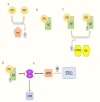A novel stop codon mutation in STK11 gene is associated with Peutz-Jeghers Syndrome and elevated cancer risk: a case study
- PMID: 37767326
- PMCID: PMC10520397
- DOI: 10.22037/ghfbb.v16i2.2751
A novel stop codon mutation in STK11 gene is associated with Peutz-Jeghers Syndrome and elevated cancer risk: a case study
Abstract
Based on the analysis of patients with Peutz-Jeghers syndrome (PJS), Serine threonine kinase11 (STK11) is known as a tumor suppressor gene, which is involved in cell polarization, regulation of apoptosis, and DNA damage response. In this case report study, we examined STK11 gene sequencing in a 42-year-old woman with mucocuta neous pigmentation and positive family history. Endoscopy and colonoscopy showed >1000 polyps throughout the stomach/colon (PJ-type hamartomas). The larger polyp in the stomach was resected and the small bowel imaging detected multiple jejunum/ileum small polyps. The data released from the sequencing results revealed five alterations in exons 1 to 5. The major mutation in stop codon was reported as converted to the amino acid tryptophan (TRP) to tyrosine (TER). The TGG codon was converted to TAG by mutation. Finally, another novel mutation in STK11 stop codon as a 'de novo' variant was seen. It is predicted that stop codon mutations make the affected person susceptible to developing colorectal cancer.
Keywords: Genetic analysis; Novel mutation; Peutz-Jeghers syndrome (PJS); STK11gene; Sequencing.
© 2023, Gastroenterology and Hepatology From Bed to Bench (GHFBB).
Conflict of interest statement
Authors have no potential conflicts of interest to disclose.
Figures


Similar articles
-
A novel germline mutation (c.A527G) in STK11 gene causes Peutz-Jeghers syndrome in a Chinese girl: A case report.Medicine (Baltimore). 2017 Dec;96(49):e8591. doi: 10.1097/MD.0000000000008591. Medicine (Baltimore). 2017. PMID: 29245219 Free PMC article.
-
Peutz-Jeghers syndrome: early clinical expression of a new STK11 gene variant.BMJ Case Rep. 2015 Oct 1;2015:bcr2015211345. doi: 10.1136/bcr-2015-211345. BMJ Case Rep. 2015. PMID: 26430231 Free PMC article.
-
Sanger sequencing in exonic regions of STK11 gene uncovers a novel de-novo germline mutation (c.962_963delCC) associated with Peutz-Jeghers syndrome and elevated cancer risk: case report of a Chinese patient.BMC Med Genet. 2017 Nov 15;18(1):130. doi: 10.1186/s12881-017-0471-y. BMC Med Genet. 2017. PMID: 29141581 Free PMC article.
-
Extremely young case of small bowel intussusception due to Peutz-Jeghers syndrome with nonsense mutation of STK11.Clin J Gastroenterol. 2019 Oct;12(5):429-433. doi: 10.1007/s12328-019-00964-0. Epub 2019 Mar 19. Clin J Gastroenterol. 2019. PMID: 30888642 Review.
-
Solitary Peutz-Jeghers Type Polyp of Jejunum with Gastric Fundic and Antral Gland Lining Mucosa: A Case Report and Review of Literature.Int J Surg Pathol. 2022 Aug;30(5):539-542. doi: 10.1177/10668969211067760. Epub 2021 Dec 27. Int J Surg Pathol. 2022. PMID: 34955063 Review.
Cited by
-
Evaluating predictors of kinase activity of STK11 variants identified in primary human non-small cell lung cancers.Hum Genet. 2025 Mar;144(2-3):127-142. doi: 10.1007/s00439-025-02726-0. Epub 2025 Feb 12. Hum Genet. 2025. PMID: 39934475 Free PMC article.
-
Evaluating predictors of kinase activity of STK11 variants identified in primary human non-small cell lung cancers.Res Sq [Preprint]. 2024 Jul 2:rs.3.rs-4587317. doi: 10.21203/rs.3.rs-4587317/v1. Res Sq. 2024. Update in: Hum Genet. 2025 Mar;144(2-3):127-142. doi: 10.1007/s00439-025-02726-0. PMID: 39011112 Free PMC article. Updated. Preprint.
References
-
- Ciçek Y, Ertas U. The normal and pathological pigmentation of oral mucous membrane: a review. J Contemp Dent Pract. 2003;4:76–86. - PubMed
-
- Chen HY, Jin XW, Li BR, Zhu M, Li J, Mao GP, et al. Cancer risk in patients with Peutz–Jeghers syndrome: a retrospective cohort study of 336 cases. Tumor Biol. 2017;39:1010428317705131. - PubMed
Publication types
LinkOut - more resources
Full Text Sources
